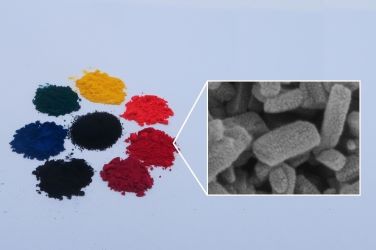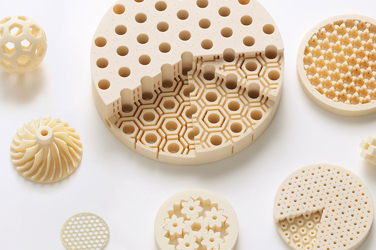
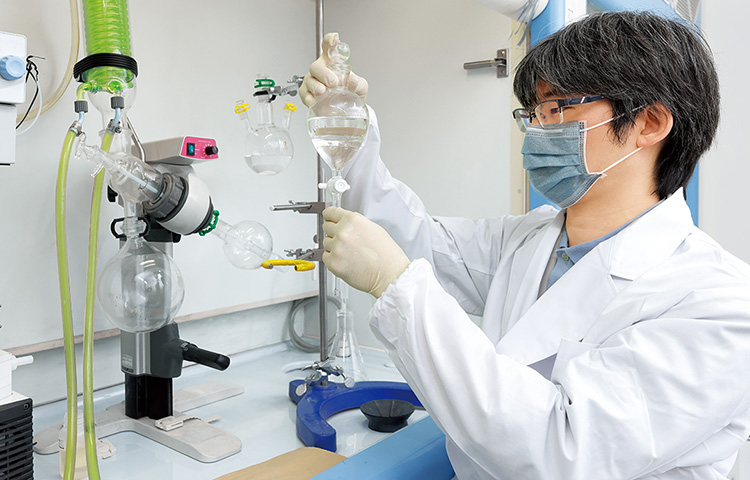
Technological Infrastructure to Improve Product Performance and Boost Competitiveness
Materials Development Platform
Canon has built up materials technologies through the development of a wide range of products such as cameras, printers, and office multifunction devices . We have systematized these technologies into a proprietary materials development platform which serves as a company-wide technological infrastructure in the development of products of all kinds, improving product performance, and boosting competitiveness.
October 16, 2023
Our Materials Development Platform Supports Product Evolution and the Creation of New Businesses
Materials are an important element that impacts product performance. When classified according to the functions performed by materials, the material technologies that Canon has accumulated through the development of interchangeable lenses, printers, etc. are divided into four categories. These are (1) technology for creating color, (2) technology for adjusting light, (3) technology for transmitting and blocking heat and electricity, and (4) technology for creating force. For each material, which fulfills one of these four functions, Canon has built up a set of technologies that combines "design of the material that provide high functionality," "synthesis and processing" that realize the functional design of the material, "manufacturing" that enable its production in the quantity and quality enough to be used in products, and "analysis, measurement, and evaluation" to confirm that the material is produced as intended.
Canon has systematized these technologies to establish a "materials development platform" as a technological foundation across the Group, and uses it to further improve its products and to launch new businesses earlier to provide customers with high value-added products in a timely manner.

Four features that enhance product performance
Streamlining Development with Our Own Materials Database
In developing cameras, printers, displays, and other color-related products, Canon has made advances in technologies for creating new colors and enhancing coloration properties aimed at expanding the range of color expression. For example, ink used in printers is composed of "colorants," which are the raw materials for color, and resins and solvents that determine the functional properties of the ink, such as its ability to adhere to paper surfaces and to dry quickly. The more evenly the colorants are dispersed in the ink, the better the color will be. Our nanometer-level design technology, which ensures uniform dispersion of colorants in ink, and our manufacturing technology, which uniformly mixes colorants and resins, enable rich color expression.
Materials development once took years, relying on the knowledge and experience of engineers in an iterative process of prototyping, evaluation, and verification. Canon has now consolidated into a database all of the information on material characteristics and experimental data from R&D processes to serve as a material bank.This system, which utilizes the knowledge accumulated by engineers with the help of AI, contributes to identifying new materials with the necessary functions. It improves our developmental efficiency and allows us to find new materials that will boost the competitiveness of Canon’s businesses, utilized in development of light-emitting materials for displays, and other areas of material development.
Using Materials Technology Developed In-house for Better Performance and High Value-added Products
Particularly in interchangeable camera lenses, high product performance thanks to materials technology gives the product an enormous competitive edge.
Interchangeable lenses focus light to form images. Because common optical materials have different refractive indices for each of the red, green, and blue lights that make up natural light, ordinary lenses cannot collect light into a single point to create a sharp image. Instead, there is a misalignment called chromatic aberration, which causes color fringing and image blurring. A crucial performance feature for interchangeable lenses is therefore the ability to suppress chromatic aberration.
Blue light is particularly difficult to control, and commonly available materials do not offer the optical performance that Canon requires. So we went ahead and synthesized our own optical material, starting even from the molecular design. By combining this new optical material with glass materials, we succeeded in dramatically reducing chromatic aberration. The result was Canon’s Blue Spectrum Refractive Optics (BR) Lens, an optic element incorporated into our EF35mm f/1.4L II USM, RF85mm F1.2 L USM and other lenses, making possible superior imaging performance.
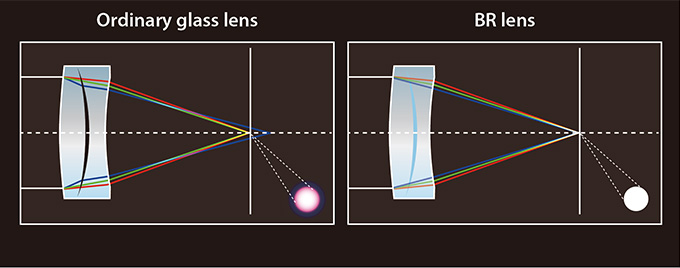
Controls blue light—a solution to achieve sharp images
Materials Technology Built through Current Businesses Leading to New Businesses
While eliminating chromatic aberration is important, more must be done to help photographers achieve high image quality and imaging performance. Reducing light reflection is one of those things. Light reflection occurs at the boundaries between a lens surface and the air due to the difference in refractive index. The reflected light causes ghosting (results in an image containing artifacts that aren't actually there) and flare (causes a part of the photo image to become whitish), which degrade image quality. Which degrade image quality. Coating technologies for the lens surface that reduce reflection are therefore indispensable for high-performance lenses.
Air Sphere Coating (ASC) is an anti-reflective coating technology that applies a film consisting of silicon dioxide and air over the vapor deposition coatings. The film, containing a certain percentage of air with lower refractive index than optical glass, forms an ultra-low refractive index layer. ASC has excellent anti reflective effects, particularly with respect to incident light that enters almost vertically.
Subwavelength Structure Coating (SWC) is a technology that controls light using a coating method. This technology suppresses the reflection of light by eliminating the boundary surface where two materials with very different refractive indices meets by forming a countless number of nano-scaled* needle-like conical structures on the lens surface. This technology is highly effective in wide-angle lenses, reducing reflections where the light comes in at oblique angles.
* One nanometer equals one billionth of a meter
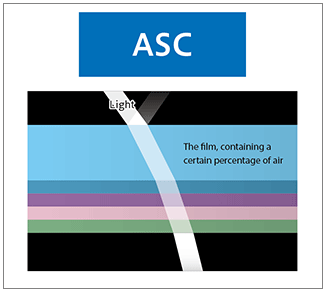
An anti-reflective coating technology that applies a film consisting of silicon dioxide and air over the vapor deposition coatings

An arranged structure of needle-like cones changes the refractive index and reduces surface boundary reflection
Coating technologies to control light
These coating technologies are being used in other businesses, such as films that clear the field of view of network cameras. In addition, they are also being applied in new fields, such as in paints that suppress the reflection of display surface. Thus, these technologies are expected to contribute to strengthening the competitiveness of Canon's businesses.
Application to anti-reflective paint
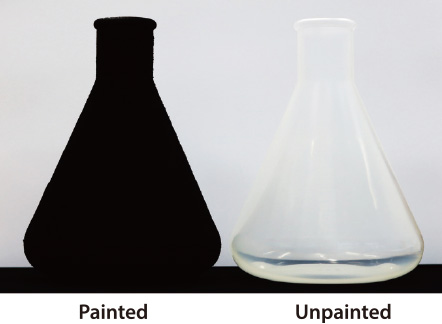
Due to lack of light reflection, the depth of objects is hard to recognize (Photo: anti-reflective paint on a flask)


